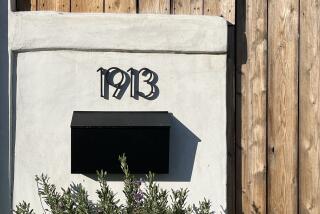It’s not just swimming pools, movie stars
Beverly Hills is more than lavish residences, posh shopping or a ZIP Code of television fame. The city has its own schools, police and fire departments and city government. Its 35,000 residents share a sense of community whether they live on a vast estate or in a cozy studio apartment in any of the three ZIP Codes.
Between the city and the sea
Charles Canfield, Burton Green and Max Whittier purchased the Hammel and Denker ranch in early 1906 in search of oil. The ranch -- an area bounded today by Wilshire Boulevard to the south, the foothills just above Sunset Boulevard to the north, Whittier Drive on the west and Doheny Drive to the east, was part of the land grant known as El Rodeo de Las Aguas (the Ranch of the Gathering Waters).
When minimal oil was found (a well remains within the city today), the developers adjusted their vision and decided to develop the land. In addition to luxury housing, they wanted to build a community that would be self-sufficient, with shopping, business areas, parks and multifamily housing. They hired Wilbur David Cook Jr., a leading community planner and landscape architect, to design a balanced, multitiered community, with separate housing for the myriad workers and business districts needed to keep a small town running.
The development opened in October 1906, but was considered to be in the “boondocks” at the time, with downtown Los Angeles about seven vacant miles away. Advertised as “perfectly located between downtown Los Angeles and the Pacific Ocean,” the area needed more than a geographic boast.
To help attract buyers, the Beverly Hills Hotel was built in 1912 along Sunset Boulevard, both as a luxurious focal point for the community and as a place for prospective buyers to spend the night. The stunning Mission-style hotel, facing Sunset Boulevard between Crescent Drive and Hartford Way, remains a popular place to visit.
Residential lots were available in three geographic “tiers.” The foothills above Sunset Boulevard provided the first tier with flat estate-sized lots more than an acre in size. The second-tier lots, between Sunset and Santa Monica boulevards, were an average of 85 feet wide and 175 feet deep. To the south, single-family lots between Santa Monica and Wilshire boulevards averaged 50 feet wide and were 100 to 150 feet deep.
Well-rooted
Horticulturist John J. Reeves was hired in the early 1900s to plant a variety of trees along every parkway and throughout the parks. Flourishing trees line every street and are maintained by the city’s Urban Forestry Division. The Beverly Hills City Council approved a street tree master plan in 1996, laying the groundwork for replacing any street trees that outgrew their space or need removal. Only city-authorized agents are allowed to prune, remove or attach anything to a city tree, according to the municipal code.
Safety first
Viritually every intersection in the city has a traffic light or four-way stop -- even short residential streets. Between Wilshire and Santa Monica boulevards in the “Golden Triangle” business district, the city created diagonal pedestrian crossings at busy intersections along one-way streets.
Good news, bad news
The city has long prided itself on classic architecture and meticulous landscaping. Since the 1980s, however, new home construction and remodeling have caused friction between neighbors. Modern homes with minimal landscaping have offended some who wanted to protect the original “distinguished architectural character and scale” of the area. As a result, the city of Beverly Hills published the Residential Design Incentive/Reward Catalogue to “provide guidance for designing and building a new home or remodeling an existing residence.” Those following the style guidelines are permitted to add extra square footage.
On the market
About 50 homes are for sale within the city limits, 10 of which range from $1,295,000 to $1,990,000 on lots averaging 6,500 square feet.
North of Wilshire Boulevard, homes start at $2 million. About 16 homes listed at more than $7 million have lots between 19,000 and 94,000 square feet in size.
Report card
The Beverly Hills Unified School District has four elementary schools for students up to eighth grade. On the 2004 Academic Performance Index, Beverly Vista scored 883 out of 1,000; El Rodeo, 869, and Hawthorne and Horace Mann both scored 862.
Beverly Hills High School, which serves the entire city, reported a score of 822.
Historical values
Residential resales in the 90210, 90211 and 90212 Zip Codes:
Year...Median Price
1990...$1,105,000
1995...$684,000
2000...$1,070,000
2003...$1,277,500
2004...$1,650,000
Sources: DataQuick Information Systems, api.cde.ca.gov, www.beverlyhills.org, www.beverlyhillscc.org, themls.com.




